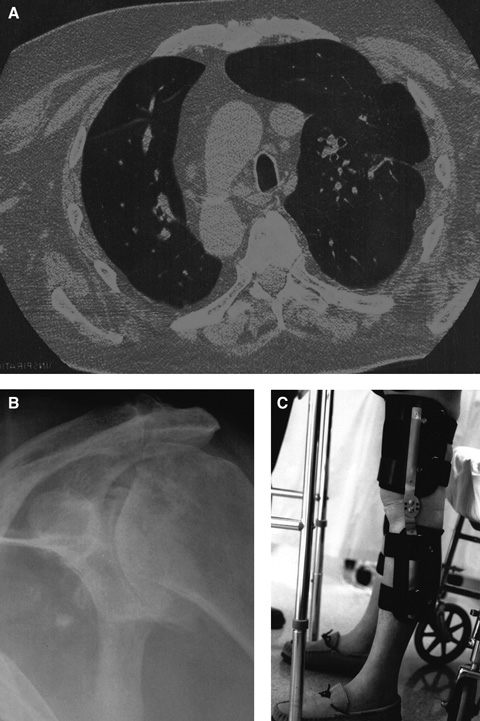Clinical record
In November 2006, a 59-year-old man was admitted to hospital with a 5-week history of dyspnoea secondary to type I respiratory failure, generalised weakness, poor mobility, and bilateral shoulder and knee pain. He had been diagnosed with inclusion body myositis in 1998. Comorbidities included systemic lupus erythematosus, pulmonary hypertension, interstitial pulmonary fibrosis (Figure, A), type 2 diabetes, obstructive sleep apnoea and gout; and he had undergone a bilateral total hip replacement, which enabled him to walk a limited distance unaided. Six months earlier, his general practitioner had noted a functional decline caused by a combination of poor pulmonary function, myositis and inactivity, which resulted in the patient requiring a wheelchair for mobility and help from his son with some activities of daily living. Methotrexate and azathioprine, which had been prescribed for management of the underlying connective tissue disease, were thought to be contributing to the respiratory failure and were withdrawn. Prednisolone therapy (50 mg daily) was begun, and some improvement in respiratory function was noted after 2 weeks. However, the patient did not regain baseline function and remained bed-bound, requiring assistance with all activities of daily living. Admission to a high-level residential care facility was considered, but the patient wanted to return home with his son as carer.
This case highlights the capacity of therapeutic exercise, pulmonary rehabilitation, pain management and use of orthoses to reduce the impact of disability, restore function and potentially allow patients to live at home with family and community support. Our patient had several comorbid conditions that required specific management, in addition to general deconditioning after his acute illness.
Inclusion body myositis. This late-onset inflammatory muscle disease results in impaired muscle function, muscle atrophy and weakness, affecting both proximal and distal muscles. It accounts for 17%–30% of idiopathic inflammatory myopathies and can be associated with autoimmune diseases.2-4 In the past, patients with myositis were discouraged from exercising owing to a fear of increased muscle inflammation. However, studies in the 1990s reported that exercise might have a non-specific benefit.5 Patients with inflammatory muscle disease benefit from mild to moderate muscle training and endurance exercise, and muscle inflammation does not increase after exercise.6-8 A specifically tailored rehabilitation program improved our patient’s physical function without evidence of increased muscle damage.
Interstitial pulmonary fibrosis. This group of lung diseases affects the interstitium of the lungs, eventually causing restrictive lung disease. Pulmonary rehabilitation — involving strength and endurance training for arm and leg muscles (eg, walking, cycling, lifting small weights), education on energy conservation and anxiety management, chest physiotherapy, and breathing techniques such as pursed lip and diaphragmatic breathing — has been shown to reduce dyspnoea, improve exercise capacity, enhance quality of life and reduce hospitalisation.9
Chronic shoulder pain from arthritis. This type of pain can be safely and effectively treated by suprascapular nerve block, which avoids the side effects of oral analgesics.10 In our patient, it was an essential component of the rehabilitation program because it enabled him to perform activities of daily living and use a walking frame. Intra-articular steroid injection was not used as it might have worsened the avascular necrosis of the head of the left humerus.
Genu recurvatum. This is an angular deformity (hyperextension at the knee) in the sagittal plane caused by quadriceps weakness. Mediolateral (valgus and varus) instability occurs in the coronal plane. Both deformities require three-point stabilisation. In our patient, orthoses with a free-motion joint and a hyperextension block controlled both deformities and allowed knee movement during walking.11 Gait training with such orthoses includes static weight shift and dynamic balancing exercise in parallel bars, followed by progression to a normal gait pattern.
Lessons from practice
Patients with inflammatory muscle disease benefit from mild to moderate muscle training and endurance exercise.
Pain, deformity and deconditioning are major contributors to disability, and amplify the effects of underlying medical conditions.
The goals of multidisciplinary rehabilitation are to restore function and to enhance quality of life.
Active rehabilitation should always be considered, regardless of the apparent severity of underlying medical conditions.






We acknowledge Maree Braithwaite (Occupational Therapist), Nicolle Datson (Physiotherapist) and Jessica Quayle (Orthotist) of St Margaret’s Rehabilitation Hospital for assisting in the management of our patient. We also thank Dr Roger Hunt and Dr Alistar Bonin of Western Adelaide Palliative Care for reviewing the manuscript.
None identified.